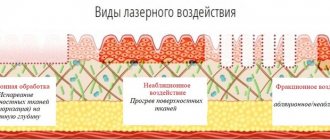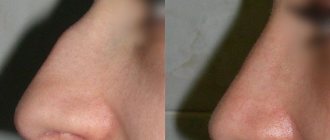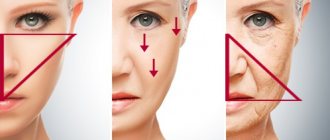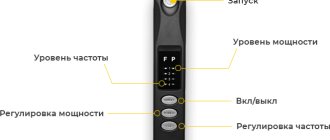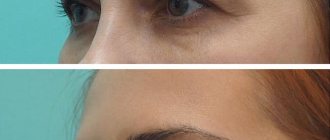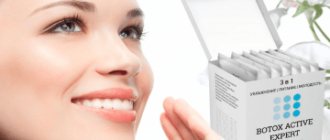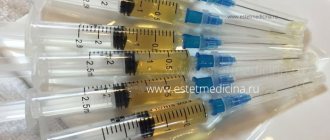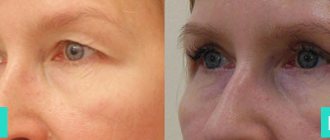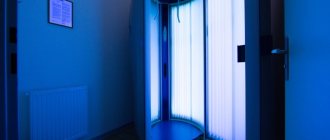Facial anatomy
The key to understanding the reasons for the development of complications after filler injections is knowledge of the structural features of the face.
Main 5 structural layers:
- Skin (it consists of epidermis and dermis).
- Subcutaneous fat deposits.
- Facial muscles, SMAS.
- Blood vessels.
- Skull bones.
With any contour plastic surgery, there can be either a standard number of dangerous zones or an increased number - if, for example, surgical interventions were previously performed in the facial area. At the appointment, the cosmetologist asks the patient in detail about diseases and operations previously undergone - this allows him to assess the risks as accurately as possible and reduce the likelihood of adverse reactions to a minimum.
Which filler should I choose?
Before the procedure, you must have a consultation with a dermatovenerologist, after which you decide on the amount of the drug administered.
In ours, we work with drugs from Germany, France, etc.
German products:
- Belotero is a line of 5 fillers based on hyaluronic acid (HA).
- Radiesse. The filler drug Radiesse (/oprodukcii/radiesse-1-5-ml) is a German development. It is based on calcium hydroxyapatite. Structural characteristics allow it to be introduced deeper than analogues. With its help, cosmetologists solve problems with deep wrinkles.
French products:
- Esteline - Hyaluronic acid of the highest purity, created on the basis of the safe reticular agent BDDE.
- Juvederm - has excellent density and viscosity, is completely safe, does not provoke inflammatory or allergic reactions.
- Evolution. Innovative development. Hyaluronic acid molecules stabilized in laboratories, when they get under the skin, begin to change their structure. In this state, they are resistant to the action of enzymes that destroy them.
- Surgiderm is a gel based on hyaluronic acid with a patented matrix structure of the molecules of the main active ingredient.
How are blood vessels located in dangerous areas?
The most dangerous areas of the face during contouring are those where arterial and venous vessels lie. If you get into them with dermal filler, you can lead to ischemia, skin necrosis, and loss of vision. Arterial occlusion causes scarring, ulcerative formations, and occlusion of the ophthalmic artery can cause vision loss. Occlusion of arteries and veins can develop either as a result of injection of the drug directly into the vessel, or due to external pressure on it due to a large volume of gel or edema. This condition is rare, but quite dangerous and requires immediate intervention.
The main danger zones of the face during contouring:
- cheeks – transverse, facial artery, buccal branch of the maxillary artery, zygomatic branch of the buccal artery, infraorbital artery;
- glabella - supraorbital and frontal arteries;
- nose – angular, external nasal vessels;
- perioral zone – inferior and superior labial arteries;
- temples - temporal artery (anterior frontal and posterior parietal branches).
Salon treatments at home
You can use salon products at home, but not always. The easiest way to get high-level care at home is to purchase a ready-made mask from the professional series. Here it is only important to choose a product depending on the condition of your skin and follow the instructions. But with peeling, cleansing and home rejuvenation, the situation is not so harmless.
You can clean it at home, but you shouldn’t be overzealous. A cosmetologist removes blockages and pimples professionally. You cannot carry out this procedure yourself; traces of your manipulations may remain. The maximum that is allowed in this case at home is to steam the skin in a water bath, use a scrub and make a cleansing mask.
If you decide to exfoliate at home, choose only mild, superficial peeling products and do a preliminary test on an inconspicuous area of skin.
Possible complications: how they manifest themselves and what to do
Any change in skin tone immediately after administration of the drug may indicate vascular ischemia. Symptoms of arterial and venous occlusion are complete discoloration of the epidermis or its darkening to a bluish-gray tint, reticular erythema, ecchymosis, severe headaches. The main thing in this case is to start blood flow processes in the affected area. Ways to do this (done by a doctor!):
- applying a compress (it should be warm);
- massage aimed at dilating blood vessels and uniformly dispersing the drug;
- the use of stimulant drugs to dilate external blood vessels;
- taking aspirin;
- hyaluronidase injections (if problems are caused by hyaluronic acid preparations);
- corticosteroid injections (anti-inflammatory/immunomodulatory drugs);
- taking systemic antibiotics;
- antiviral therapy (indicated when there is a threat of necrosis in the perioral zone).
Hyperbaric oxygen therapy and a course of laser procedures may be prescribed several months after the injection of filler and the development of occlusion. Although this complication is very rare, it is worth knowing about. To avoid damage to the vessels of the retina, fillers are not injected into the area of the glabella and the upper part of the nasolabial folds.
During 3D modeling in our clinic, three people are involved in the process of creating an image: the patient, a plastic surgeon and a highly professional artist who knows the method of anatomical reconstruction. Thus, during modeling, the wishes of the patient, the recommendations of the artist and the capabilities of the surgeon are taken into account.
Over several years of work, the VIP Studio laboratory has completed hundreds of 3D facial modeling.
I would like to note that the understanding of a harmonious face and the requirements for future appearance are quite similar for most patients. After analyzing our experience, we came to unusual conclusions:
1. The middle third of the face receives the most attention.
2. In the middle third of the face, the infraorbital region is most often modeled, and not the nose, as one might assume.
3. It is quite rare to order cheekbone enlargement in the lateral direction. Patients do not strive to have wide cheekbones.
4. When choosing an appearance, the key points for many are the eyelid-cheek transition, the location of the point of greatest protrusion of the cheek forward and the continuity of the contour of the cheek when turning in profile.
Thus, if you give the patient freedom of choice, he does not at all strive for template model cheekbones, as on the covers of glossy magazines. To my surprise, the modeling that we do according to the wishes of our patients does not in any way coincide with the generally accepted canons described in plastic surgery.
Selection of midface implants
There is a well-known standard for the selection of midface implants, the founder of which is the American doctor Binder. He expressed ideas for a zonal approach, identifying five zones in the midface, meaning that each zone needed its own implant. The technique is convenient because it offers ready-made solutions and implants.
The diagram identifies 5 zones of the middle part of the face and 3 zones of the lower jaw. The zones are very arbitrary and are of little use in clinical practice.
According to Binder, it is proposed to distinguish 3 types of deformations and use ready-made implants to correct them.
To change the appearance in the desired direction, we create individual implants for each patient. So, the implants that our patients required differ significantly from those offered by facial implant manufacturers.
Based on the data we received, the conclusions arise that either Russian women have different tastes, or the canons for choosing implants proposed by Binder require revision. I'm leaning towards the latter because technical capabilities have improved significantly since the nineties when this concept was developed.
So, Binder’s concept is in fact far from the demands that clients present to us. Moreover, in practice it turned out that patients do not want to comply with the zoning principle, and the implants that they really need are very different in shape and size from those available on the market.
Rice. 1 This implant corrects the retraction of the upper lip, lifts the tip of the nose, eliminates nasolabial folds and gives a sharply defined relief to the cheekbone. The client is a professional fashion model.
Rice. 2 The implant is designed to fill the gaps under the eyes, fill the cheek and cheekbone forward, and raise the base and tip of the nose.
Disadvantages of contouring with gels
You will probably notice that contouring can be easily and safely done with fillers. This is a fair point, but there are certain limitations.
Tyndall effect
. Hyaluronic acid is transparent. Differences in the optical density of human tissue and filler sometimes become visible to others. The infraorbital area or cheek may develop a bluish tint, and the nose may become transparent. The more superficially the filler is introduced and the more of it, the higher the likelihood of the Tyndall effect.
Size matters.
A large mass of filler can not only cause the Tyndall effect, but also ptosis, create the effect of puffiness of the face, and when smiling, creep into the eyes. It is impossible to indefinitely increase the thickness of soft tissues; this becomes obvious in one form or another.
Rice. 1 Blue glow in the naso-buccal groove with a large amount of hyaluronic acid.
Rice. 2 Transillumination of the nasal bridge during the introduction of hyaluronic filler.
Rice. 3 Increased cheekbone projection using filler in the infraorbital area. Creeping of cheek tissue onto the eyelid when smiling.
Danger zones.
Deep injection of fillers is often preferred. However, there are areas in the midface where this is not safe. Complications: needle injuries to blood vessels and severe bleeding, embolism, nerve injury and sensitivity disorders.
The CT scan shows Radiesse filler injected at the exit site of the infraorbital nerve. Nerve compression with filler. The patient complains of decreased sensitivity of the cheek and upper lip, neuralgic pain.
Bone or soft tissue
The ideal solution would be for soft tissues to be corrected with soft implants, and facial imbalances with bone grafting or hard implants. Bone is the supporting tissue for the soft tissues of the face and it will not be possible to lift, for example, the edge of the orbit, pyriform opening, or give a faceted shape to the cheekbone with a soft and displaceable filler.
For the middle third of the face, foreign companies offer all kinds of standard-shaped implants: they need to be sharpened, tried on, inserted, pulled out, trimmed, and so on. The technology for manufacturing individual implants allows them to be very well adjusted and adapted to the skull - they fit onto the bone like a key to a lock and require virtually no fixation. We create anchor points where they fit well. Without touching the person, we virtually create a beautiful appearance for him, calculate the implant and place it through a small incision in the mouth. It can also be placed through the eyelid, but it is preferable to do it through the mouth - no external stitches.
Installation of a complex implant through a 1 cm incision in the oral vestibule mucosa.
After the technology for manufacturing such implants was tested, I asked myself: “Why do some people need them and others don’t? What's the difference? After the studies, it turned out that variations in the structure of the lower edge of the orbit are much more likely to create aesthetic problems than the zygomatic bone.
A large number of patients who come to me after complications of lower blepharoplasty have problems with the midface. A complication known as round eye often occurs with a so-called negative vector, when the edge of the orbit is not sufficiently advanced in relation to the cornea.
Other common pathology
– when the height of the lower orbital rim is not enough.
To create an even transition between the eyelid and cheek, you have to do a number of interventions, such as fat-saving surgeries, endoscopic lifts, you have to place implants and spacers in this area in order to somehow achieve an acceptable appearance of the undereyes. Our research has shown that a lot of traumatic surgical procedures can be avoided if you pay attention to the structural features of the skull in the middle zone.
We found out that there are different orbital inclination angles, and there are, for example, giant orbits that create a lot of aesthetic problems. On the contrary, the shape of the Asian orbit is close to round and Asians are unaware of most of the problems of the European lower eyelids.
Rice. 1 The shape of the Asian orbit is close to a circle. Rice. 2 Asian lower eyelid is shorter. The transition between eyelid and cheek is smooth. Hernias of the lower eyelids and hollows under the eyes are less pronounced.
Ideal European skull. The shape of the eye sockets is “aeronaut glasses”.
Sunken lower edge of the orbit. Negative vector. The patient asked for removal of false hernias of the lower eyelid.
Insufficient height of the lower edge of the orbit. "Giant" orbit. Upon treatment, I was concerned about “dips” under the eyes.
An ideal skull and a beautiful face
I found several beautiful girls with harmonious skulls and, using the capabilities of our virtual plastic studio, I began to try on the skulls of those patients who needed implants of the lower edge of the orbit and cheekbones.
It turned out that a large number of people who are dissatisfied with their appearance have significant deviations and fluctuations in the structure of both the cheekbone and the lower edge of the orbit. Such differences provide a lot of prerequisites for variations in techniques for lifting and eyelid surgery. Striving for ideal contours, we intensively modify soft tissues, but do not try to make the skull ideal, which automatically provides us with ideal external contours.
Changing the contour of the infraorbital region after installation of an individual implant.
This is not a public offer! There are contraindications. Before use, consultation with a specialist is required.
What are the advantages of implants? No bone grafting required. Everything is done simply and quickly: the necessary implants are installed through the mouth, trauma is significantly reduced, there are no external stitches, and rehabilitation is short. We get stable and predictable results.
Changes in the infraorbital, buccal and paranasal areas, elevation of the tip of the nose after installation of a single implant through the mouth.
This is not a public offer! There are contraindications. Before use, consultation with a specialist is required.
Round eye after lower blepharoplasty and chick lift. A lower edge of the orbit-cheek-paranasal implant was installed. Canthoplasty.
This is not a public offer! There are contraindications. Before use, consultation with a specialist is required.
The giant orbit, cheek and under-eyes were adjusted, and the position of the upper lip and tip of the nose was changed. 1 month after surgery.
This is not a public offer! There are contraindications. Before use, consultation with a specialist is required.
Implant to correct the shape of the orbit and the edge of the pyriform opening.
So, using these beautiful skull templates that we have, we have learned to analyze and create exactly the implants that our patients need.
To communicate with patients who have undergone facial rejuvenation, come to our forum, section Anti-aging surgeries


